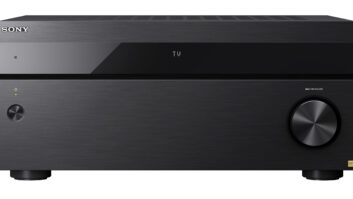With the shifting sands of new technology, changing content distribution channels and consumer usage patterns, and a plethora of new formats and brand competitors all revolving around a volatile retail environment, Mike Fasulo, president of the newly renamed Sony North America, met with reporters at a press roundtable on March 4 in Beverly Hills to set out the company’s plans for its business and the marketplace, in general.

Mike Fasulo, president of the newly renamed Sony North America and Jim Belcher, VP of technology and production for the Universal Music Group, met with reporters in Los Angeles.
Addressing a hot topic straight off the bat, Fasulo firmly stated that Sony has not “spun off” either its TV, video, and sound (“VAS”) businesses in the sense that the ownership is transferred to an outside party or just plain sold (see also, Frank Sterns). Rather, Sony categorizes the recent organizational moves as “split-outs,” that put the businesses in separate units where they are not combined with any other Sony operation. The professed goals, in Fasulo’s words, are to “…give the groups clear accountability and decision-making authority with a light infrastructure.”
As an example of how this approach has previously worked well, Fasulo pointed to Sony Computer Entertainment, or SCEA, which is responsible for the PlayStation product line. SCEA was “split-off” from its roots elsewhere in the Sony organization to continue as a wholly owned, but stand-alone unit. Perhaps to make it is clear as possible to the assembled reporters, he said that “we’re not getting of, or divesting and business…we don’t have an interest in selling any of our spin-out business.”
With those statements hopefully putting the biggest business question to rest, the discussion turned to products and marketing. In other words, with the business structure revised, how will Sony get its products to market, and what will those products be?
Repeating a theme that goes back to a Kaz Harai’s CES keynote address and Fasulo’s own keynote at this past year’s CEDIA EXPO, Sony’s product direction will increasingly be aimed at premium products. These include higher-end 4K/UHD displays, 4K action cams on the vision side, and high-resolution audio on the sound side.
Both Fasulo and Sony North America deputy president Toshi Okuda pointed to the current success of their TV business with high-line sets as evidence that the plan is working. According to Okuda, the U.S. market is Sony’s largest for 4K sets, and with Sony’s fiscal year about to close, Fasulo pointed to last year as Sony’s “best in electronics in a decade.”
The push behind UHD will move in line with the industry’s theme of not just “more pixels”, but “better pixels and faster pixels.” Although Sony has dropped QD Vision’s Color IQ from its sets, they are using their own, proprietary take on quantum dots/nano-crystals for improved and more accurate color. With regard to the various high dynamic range (HDR) systems being proposed, Fasulo would not commit to any specific standard for Sony’s sets, but did hint that depending on how the final standards shake out, it may be possible to upgrade some of the current models to accommodate the eventual choice.

Sony North America deputy president Toshi Okuda pointed to the current success of their TV business with high-line sets as evidence that the plan is working.HDR is not only part of the discussion within the newly formed UHD Alliance, of which Sony is a member; it will likely be part of the “Netflix Recommended” program for set-makers first revealed at CES in January. The program, which should launch this summer, will certify sets that also offer increased speed of launch, higher overall quality, and a more consistent user experience, according to Okuda. With “Smart TV” quickly becoming a commodity feature on sets, this sort of differentiation would be a natural fit not only for Sony’s premium-oriented product plan, but also for the custom world as a whole.
On the audio side of the fence, Jim Belcher, VP of technology and production for the Universal Music Group set the business model for digital in general and HRA in particular by stating that digital is two-thirds of Universal Music’s business and that UMG’s HRA business tripled last year. UMG has released a wide range of titles in HRA, ranging from new releases from the likes of Beck and Dianna Krall to backlist catalog titles from Frank Sinatra and others.
At the moment, however, all HRA content is downloaded as there is no streaming service available for it. Belcher expects that technology within the year, along with a “designator code” system that might resemble the three-letter code used in the early days of CDs to let consumers “know the provenance” of a title. Knowing whether a track or album was originally recorded in a high-resolution format or re-mastered from an analog or earlier digital master is seen as key to broad consumer acceptance of HRA.
To reach consumers, Fasulo confirmed that Sony will be closing most of its existing Sony Stores and replacing them with a mix of “Sony Experience” centers within Best Buy, as well as expanding the outreach to key specialist retailers. A few stores in key markets such as New York and Los Angeles will remain. Online efforts will also be restructured to Sony Store content. Specialist and custom retailers are key to all of this.
“The CEDIA channel is important to us,” said Fasulo, pointing to double-digit growth for Sony in the custom market.
Fasulo set the course for the company as follows: “create the market, educate the channel and then reach out to the consumer.” His call to strengthen the market boils down to “product, process, people, and passion.”
What we are not likely to see from Sony in the near future are multi-room systems, along the lines of Sonos, Heos, and others. “We want to see MR grow,” Okuda said, “but it has to be delicious enough.” Perhaps more critically, he said that this type of product is most successful in the U.S. than elsewhere in the world. For that reason, he said it appears to also be a bit difficult for Sony’s teams to grasp the use case for it. This was not a “never happen” comment as much as a “not for a while.”







